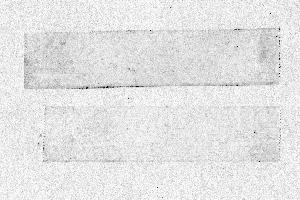I know, there I go with the titles agan – sorry. But it fits because I thought I’d start this series off with one of the simplest tests I know for cleanliness. It’s a good example of a test that, although effective, doesn’t cost a fortune and can give some pretty meaningful results. I’m not saying it’s the most sensitive test in the world and I’m not saying that it works in every situation with any kind of soil but I’ve used it many times when other alternatives have simply not been available. Most anyone can come up with a roll of “Scotch” tape and a piece of paper, and that’s all you really need.

The test involves applying one length of clear or “invisible” tape (I prefer “invisible”) to the surface being tested and then removing it from the surface and applying it to a piece of white paper. A second length of the same tape which has not seen the surface being tested is applied to the paper next to the piece that was exposed to the surface being tested and the two are compared. Contaminants collected from the surface by the first piece of tape are surprisingly visible. Particles as well as more subtle features, sometimes even including such things as fingerprints and films stick out like the proverbial “sore thumb.”
There are several variations on the basic theme described above. If, for example, the contaminant to be detected is white, you simply replace the white piece of paper with black or some other color paper that provides the needed contrast. On some surfaces it may be helpful for consistency to use a roller with a prescribed force to apply the tape to the surface under test. In most cases, however, simple finger pressure is more than adequate to do the job. The adhesive on the tape is surprisingly agressive and consistent (at least in major brands). To provide a more definitive evaluation one can use a reflection or transmission device to measure reflected or transmitted light or a simple flat bed scanner with appropriate computer software to evauate or score samples. The tape, even the frosted kind, is clear enough to allow microscopic examination to ascertain particle sizes, shapes and possibe origin.
In one application I applied this simple test to a part made of graphite. Graphite, for anyone who hasn’t tried to clean it before, is very interesting in that it never stops shedding particles (just like pencil lead). Using the tape test, it was possible to test a part that was known to be “clean” to determine what “normal” part shedding looked like vs. that of a “dirty” part. The application of two pieces of tape in succession in a criss-cross pattern (applying one vertically and then, after removing that one, applying a second one horizontally) clearly showed definition between “background” particle shedding and that associated with contamination on the part.
The test is not destructive in many applications but wouldn’t be recommended when slight surface residues might cause an issue. Another great feature of the tape test is that the evidence is easliy preserved and stored for reference as a piece of paper with two to several strips of tape attached.
Again, this test is not applicable in every application but it is a cool one to have up your sleeve in an emergency. I’ve used it many times!
Note – “Scotch” is a registered trademark of the 3M company. Like Xerox it has become a generic term. The use of the word “Scotch” does not constitute and endorsement of the 3M Company or any of it’s products. Other, similar products may work just as well in this application.
– FJF –



 English
English Spanish
Spanish Chinese
Chinese Canada
Canada Mexico
Mexico United Kingdom
United Kingdom



